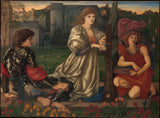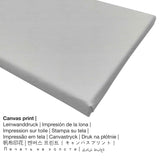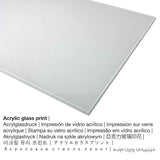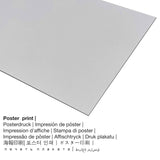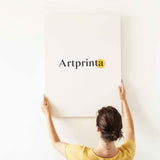Sir Edward Burne-Jones, 1868 - The Love Song - fine art print
Tax included. Shipping calculated at checkout.
In-depth art product infos
This 19th century artwork named "The Love Song" was created by the painter Sir Edward Burne-Jones. The artwork measures the size: 45 x 61 3/8 in (114,3 x 155,9 cm) and was painted on the medium oil on canvas. Today, the artpiece forms part of the The Metropolitan Museum of Art's digital collection. With courtesy of The Metropolitan Museum of Art, New York, The Alfred N. Punnett Endowment Fund, 1947 (license: public domain). In addition to that, the artpiece has the following creditline: The Alfred N. Punnett Endowment Fund, 1947. Further, the alignment of the digital reproduction is in landscape format with an aspect ratio of 4 : 3, which implies that the length is 33% longer than the width.
What would be your favorite product material option?
For every art print we offer a range of different sizes and materials. The following sizes and materials are the options we offer you for individualization:
- Poster print (canvas material): A poster print is a UV printed sheet of cotton canvas paper with a granular surface structure. Please bear in mind, that depending on the size of the canvas poster print we add a white margin of something between 2-6cm around the painting, which facilitates the framing with your custom frame.
- Glossy acrylic glass print (with real glass coating): The print on acrylic glass, which is sometimes labelled as a an art print on plexiglass, will change your favorite artwork into beautiful décor and is a distinct alternative option to canvas and dibond prints. Your own version of the work of art will be custom-made with state-of-the-art UV print technology. With an acrylic glass fine art print sharp contrasts and also small color details become recognizeable with the help of the very fine gradation of the print. The real glass coating protects your selected fine art print against light and heat for between 40-60 years.
- Canvas print: A canvas print, which shall not be mistaken with a canvas painting, is a digital image printed from a UV direct printer. Your printed canvas of this artwork will provide you with the chance of transforming your fine art print into a large size artwork like you would see in a gallery. The advantage of canvas prints is that they are relatively low in weight. This means, it is easy to hang up your Canvas print without additional wall-mounts. Hence, a canvas print is suitable for all types of walls.
- Aluminium dibond print: Aluminium Dibond prints are metal prints with an outstanding depth effect. The white & bright components of the original artwork shine with a silk gloss, however without glow. Colors are vivid and luminous, the fine details appear very clear, and the print has a a matte look you can literally feel. This direct print on Aluminum Dibond is one of the most demanded entry-level products and is an extremely contemporary way to showcase artworks, as it puts 100% of the viewer’s focus on the image.
Important note: We try our best to describe our products as closely as it is possible and to showcase them visually in our shop. Still, the colors of the print products and the imprint may vary marginally from the image on your screen. Depending on the settings of your screen and the nature of the surface, not all color pigments are printed as realistically as the digital version depicted here. Considering that all the art prints are processed and printed by hand, there might also be slight differences in the exact position and the size of the motif.
The product
| Product classification: | art copy |
| Method of reproduction: | reproduction in digital format |
| Manufaturing technique: | UV direct printing |
| Manufacturing: | German-made |
| Type of stock: | on demand |
| Proposed product use: | art print gallery, wall decoration |
| Alignment of the image: | landscape alignment |
| Image ratio: | 4 : 3 (length : width) |
| Interpretation of the aspect ratio: | the length is 33% longer than the width |
| Available material options: | metal print (aluminium dibond), poster print (canvas paper), canvas print, acrylic glass print (with real glass coating) |
| Canvas print (canvas on stretcher frame) sizes: | 40x30cm - 16x12", 80x60cm - 31x24", 120x90cm - 47x35", 160x120cm - 63x47" |
| Acrylic glass print (with real glass coating) size options: | 40x30cm - 16x12", 80x60cm - 31x24", 120x90cm - 47x35", 160x120cm - 63x47" |
| Poster print (canvas paper): | 40x30cm - 16x12", 80x60cm - 31x24", 120x90cm - 47x35" |
| Aluminium print sizes: | 40x30cm - 16x12", 80x60cm - 31x24", 120x90cm - 47x35" |
| Art print framing: | no frame |
Work of art details
| Work of art name: | "The Love Song" |
| Artwork categorization: | painting |
| General category: | modern art |
| Century: | 19th century |
| Year of creation: | 1868 |
| Artwork age: | 150 years old |
| Artwork original medium: | oil on canvas |
| Artwork original size: | 45 x 61 3/8 in (114,3 x 155,9 cm) |
| Exhibited in: | The Metropolitan Museum of Art |
| Museum location: | New York City, New York, United States of America |
| webpage: | The Metropolitan Museum of Art |
| License type: | public domain |
| Courtesy of: | The Metropolitan Museum of Art, New York, The Alfred N. Punnett Endowment Fund, 1947 |
| Creditline: | The Alfred N. Punnett Endowment Fund, 1947 |
Artist overview table
| Artist name: | Sir Edward Burne-Jones |
| Gender: | male |
| Artist nationality: | British |
| Professions: | painter |
| Country of origin: | the United Kingdom |
| Classification: | modern artist |
| Lifetime: | 65 years |
| Birth year: | 1833 |
| Died in the year: | 1898 |
Copyright © | www.artprinta.com (Artprinta)
Additional artwork information from the museum (© Copyright - The Metropolitan Museum of Art - www.metmuseum.org)
Burne-Jones associated this painting with a refrain from a Breton folk ballad: "Alas, I know a love song, / Sad or happy, each in turn." Drawing inspiration from the gothicizing Pre-Raphaelite movement, the artist conjured a twilight scene with a richly romantic, medieval air, enhanced by allusions to Italian Renaissance art, from the warm, dewy colors to the gracious figures and original frame, which recalls sixteenth-and-seventeenth-century Venetian designs. When the picture was first exhibited at the Grosvenor Gallery, London, in 1878, the novelist Henry James admiringly compared it to "some mellow Giorgione or some richly-glowing Titian."Listen to the song that inspired the painting.

